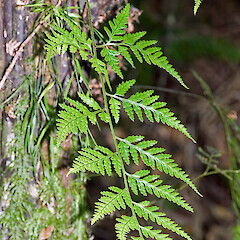Rumohra adiantiformis
Common name
leathery shield fern, florists fern
Synonyms
Polystichum adiantiforme
Family
Dryopteridaceae
Flora category
Vascular – Native
Endemic taxon
No
Endemic genus
No
Endemic family
No
Structural class
Ferns
NVS code
The National Vegetation Survey (NVS) Databank is a physical archive and electronic databank containing records of over 94,000 vegetation survey plots - including data from over 19,000 permanent plots. NVS maintains a standard set of species code abbreviations that correspond to standard scientific plant names from the Ngä Tipu o Aotearoa - New Zealand Plants database.
RUMADI
Chromosome number
2n = 82
Current conservation status
The conservation status of all known New Zealand vascular plant taxa at the rank of species and below were reassessed in 2017 using the New Zealand Threat Classification System (NZTCS) – more information about this can be found on the NZTCS website. This report includes a statistical summary and brief notes on changes since 2012 and replaces all previous NZTCS lists for vascular plants.
Please note, threat classifications are often suggested by authors when publications fall between NZTCS assessment periods – an interim threat classification status has not been assessed by the NZTCS panel.
- Conservation status of New Zealand indigenous vascular plants, 2017 . 2018. Peter J. de Lange, Jeremy R. Rolfe, John W. Barkla, Shannel P. Courtney, Paul D. Champion, Leon R. Perrie, Sarah M. Beadel, Kerry A. Ford, Ilse Breitwieser, Ines Schönberger, Rowan Hindmarsh-Walls, Peter B. Heenan and Kate Ladley. Department of Conservation. Source: NZTCS and licensed by DOC for reuse under the Creative Commons Attribution 4.0 International licence.
2017 | Not Threatened | Qualifiers: SO
Previous conservation statuses
2012 | Not Threatened
2009 | Not Threatened
2004 | Not Threatened
Distribution
Indigenous. New Zealand: Manawatāwhi / Three Kings Islands, North Island, South Island, Stewart Island/Rakiura, Chatham Islands. Also Central and South America, southern Africa, Madagascar, the Mascarenes, Seychelles, New Guinea, Australia (depending on the way R. adiantiformis is circumscribed)
Habitat
Coastal to montane. Epiphytic, lithophytic or terrestrial in forest or dense scrub. Usually in indigenous forest but also commonly seen epiphytic on willow (Salix spp.) along river banks, in gullies and on the margins of wetlands.
Wetland plant indicator status rating
Information derived from the revised national wetland plant list prepared to assist councils in delineating and monitoring wetlands (Clarkson et al., 2021 Manaaki Whenua – Landcare Research Contract Report LC3975 for Hawke’s Bay Regional Council). The national plant list categorises plants by the extent to which they are found in wetlands and not ‘drylands’. The indicator status ratings are OBL (obligate wetland), FACW (facultative wetland), FAC (facultative), FACU (facultative upland), and UPL (obligate upland). If you have suggestions for the Wetland Indicator Status Rating, please contact: [Enable JavaScript to view protected content]
UPL: Obligate Upland
Rarely is a hydrophyte, almost always in uplands (non-wetlands).
Detailed description
Rhizome 10–15 mm diameter, densely covered in long, golden brown to red-brown scales; margins entire or minutely toothed; apices acuminate. Fronds often widely spaced or aggregated toward rhizome apices, 0.2–0.9 m long. Stipes 0.2–0.8 m long, thick, densely invested by peltate, golden brown scales. Lamina 2–3-pinnate, coriaceous, 100–500 × 70–400 mm, ovate to deltoid, adaxially glossy dark green to yellow-green (sometimes pale orange-green), abaxially paler and dull, ± scaly. Primary and lower secondary pinnae stalked; ultimate segments oblong, obtused to rounded, crenate to bluntly lobed; veins immersed. Sori black when mature; indusium with a dark centre.
Similar taxa
Davallia is superficially similar. Rumohra is easily separated from the New Zealand indigenous and naturalised Davallia by the dark black, circular sori. In the wild both species are rarely found together. Davallia tasmanii subsp. tasmanii is endemic to Manawatāwhi / Three Kings Islands—where it does on occasion grow with Rumohra; while D. tasmanii subsp. cristata is known from one site in Puketi Forest, Northland.
Propagation technique
Although the New Zealand race of Rumohra is easily grown, it is slow to establish. Best results are obtained from plants attached to tree trunks of grown in hanging baskets. Rumohra prefers a humus enriched, damp free draining soil or potting medium. It does not like full sun and should not be allowed to dry out.
Etymology
rumohra: After Rumohr
adiantiformis: Resembling Adiantum, maiden hair fern
Notes on taxonomy
Rumohra adiantiformis is a polymorphic species. Some overseas races of it are popular in cultivation, where the long-lasting fronds are used for floral work. The most widespread cultivated race of this fern comes from South Africa, and this has been found sparingly established in Whanganui. The New Zealand plant has little resemblance this plant and as it is more fickly to cultivate it is unlikely to be used in the same way.
Attribution
Fact sheet prepared for NZPCN by P.J. de Lange (13 November 2012). Description adapted from Jones (1998) and Brownsey & Smith-Dodsworth (2000)
References and further reading
Brownsey PJ, Smith-Dodsworth JC. 2000. New Zealand Ferns and Allied Plants. David Bateman, Auckland, NZ. 168 p.
Jones DL. 1998. Rumohra. Flora of Australia 48, Ferns Gymnosperms and allied groups: 401–402. ABRS/CSIRO Victoria, Australia.
NZPCN Fact Sheet citation
Please cite as: de Lange, P.J. (Year at time of access): Rumohra adiantiformis Fact Sheet (content continuously updated). New Zealand Plant Conservation Network. https://www.nzpcn.org.nz/flora/species/rumohra-adiantiformis/ (Date website was queried)








